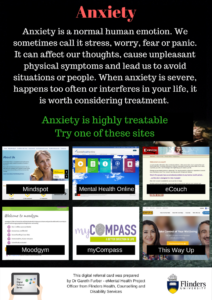
Anxiety goes by a number of names: nervousness, stress, worry, fear, panic.
Some degree of anxiety is perfectly normal. It is normal to be nervous before public speaking, normal to experience worry about things like finances or health, and normal to experience fear when confronted with a dangerous situation.
Normal or healthy anxiety typically promotes positive actions. For example, it makes us rehearse our speeches, it makes us save money for the future, and it prompts us to take action to avoid danger (e.g. wearing a seat-belt). Without some anxiety, we’d just be doing whatever felt or seemed good at the time, and would quickly get ourselves into trouble.
Anxiety can however get out of hand.
Around 2 million Australians, every year, meet criteria for an Anxiety disorder.
What distinguishes problem anxiety from normal anxiety, is the degree of impact on the individual’s life. Problem anxiety tends to lead people to avoid things: avoid the public speaking event, avoid dealing with finances or health, avoid situations that have some risk involved, and avoid people.
Anxiety disorders can take a number of different forms – each defined by the situations or things that the individual is scared of, or trying to avoid.
Specific phobias are intense fears of specific situations or objects – e.g. heights, snakes
Social anxiety is an intense fear of being criticised, embarrassed or humiliated, even in everyday situations, such as speaking publicly, eating in public, being assertive at work or making small talk
Panic disorder is the regular experience of panic attacks which are intense, overwhelming and often uncontrollable feelings of anxiety combined with a range of physical symptoms. Individuals with panic disorder come to fear these panic attacks and do everything they can to avoid them.
Generalised Anxiety Disorder (GAD) is pervasive and chronic worry about lots of different things.
Heightened levels of anxiety are also seen in other mental health disorders – such as depression, obsessive compulsive disorder (OCD) and post-traumatic stress disorder (PTSD).
The good news is that anxiety disorders respond well to treatment, including medications, cognitive-behavioural therapy (CBT), and lifestyle modifications.
CBT interventions are particularly well-suited to being delivered online, so if you suspect you might have an anxiety disorder, and would like assistance, consider the links included in the following digital referral card (clicking will download a pdf with embedded links).
I can particularly recommend the Mindspot site, as you can do an online assessment first to determine if you do meet criteria for an anxiety disorder. Often people suspect they might have an anxiety problem but are not totally sure.
Remember also that you can make an appointment to see one of our GPs or counsellors if you think you have an anxiety problem, but are not sure what to do.




